Analyzing Reward Systems: A Case Study of Lincoln Electric's Practices
VerifiedAdded on 2020/02/17
|11
|2799
|67
Report
AI Summary
This report provides an in-depth analysis of the reward practices implemented at Lincoln Electric, exploring their implications for employee performance management. It begins with an overview of the company's current reward systems, including individual incentive plans, annual bonuses, competency-based rewards, profit sharing, team-based pay, and pay for quality. The report then delves into alternative reward practices that could enhance employee motivation and satisfaction, such as flexibility in working hours, recognition programs, training opportunities, fostering a sense of belonging, providing opportunities for contribution, and offering fringe benefits. The analysis reveals that Lincoln Electric's current system, primarily monetary in nature and performance-based, has contributed to employee satisfaction. However, the report suggests that the company can improve employee motivation and overall performance by incorporating a more diverse and flexible reward system. The report also highlights the need for flexible working hours, enhanced recognition, and development of employee union for addressing employee concerns. The study concludes with recommendations to improve the current system.
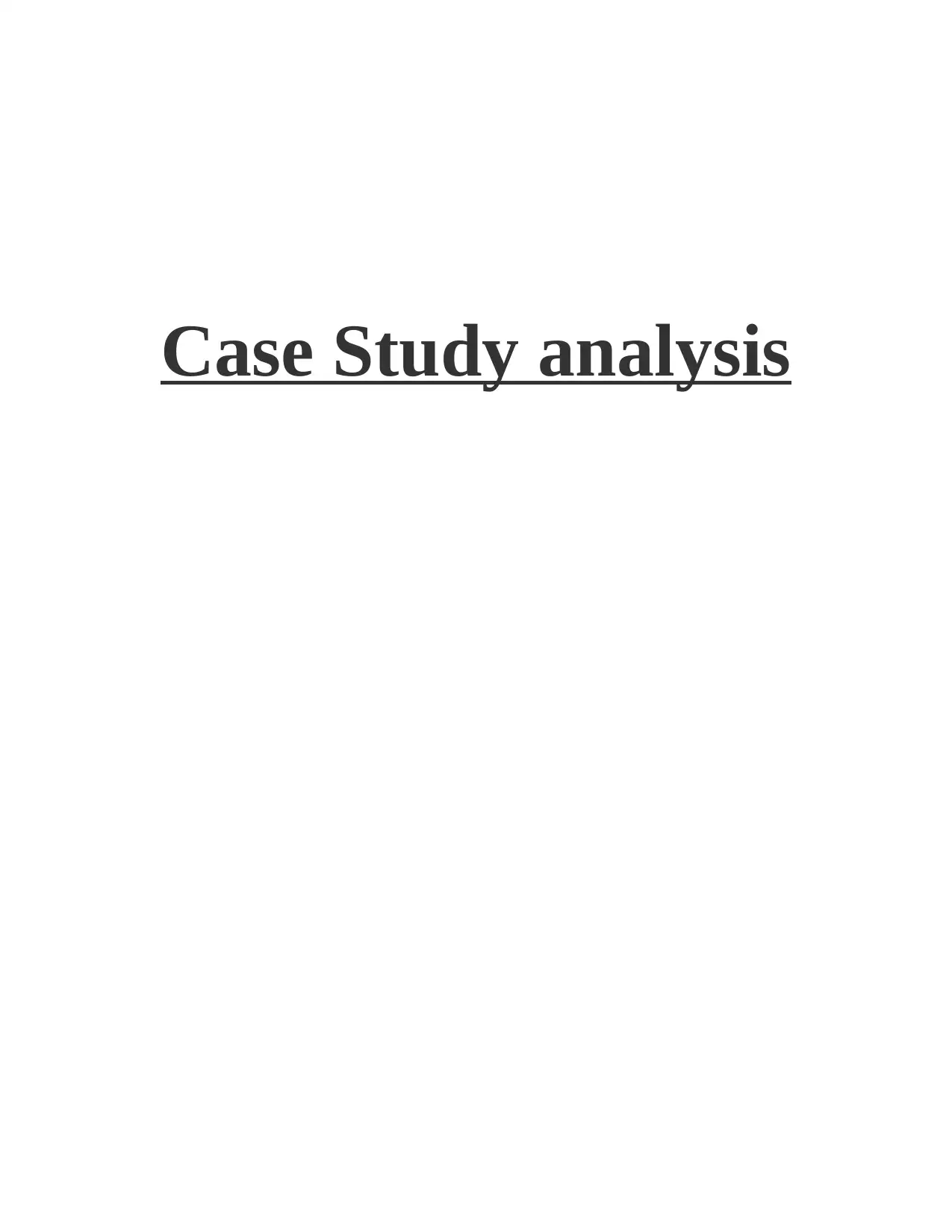
Case Study analysis
Paraphrase This Document
Need a fresh take? Get an instant paraphrase of this document with our AI Paraphraser
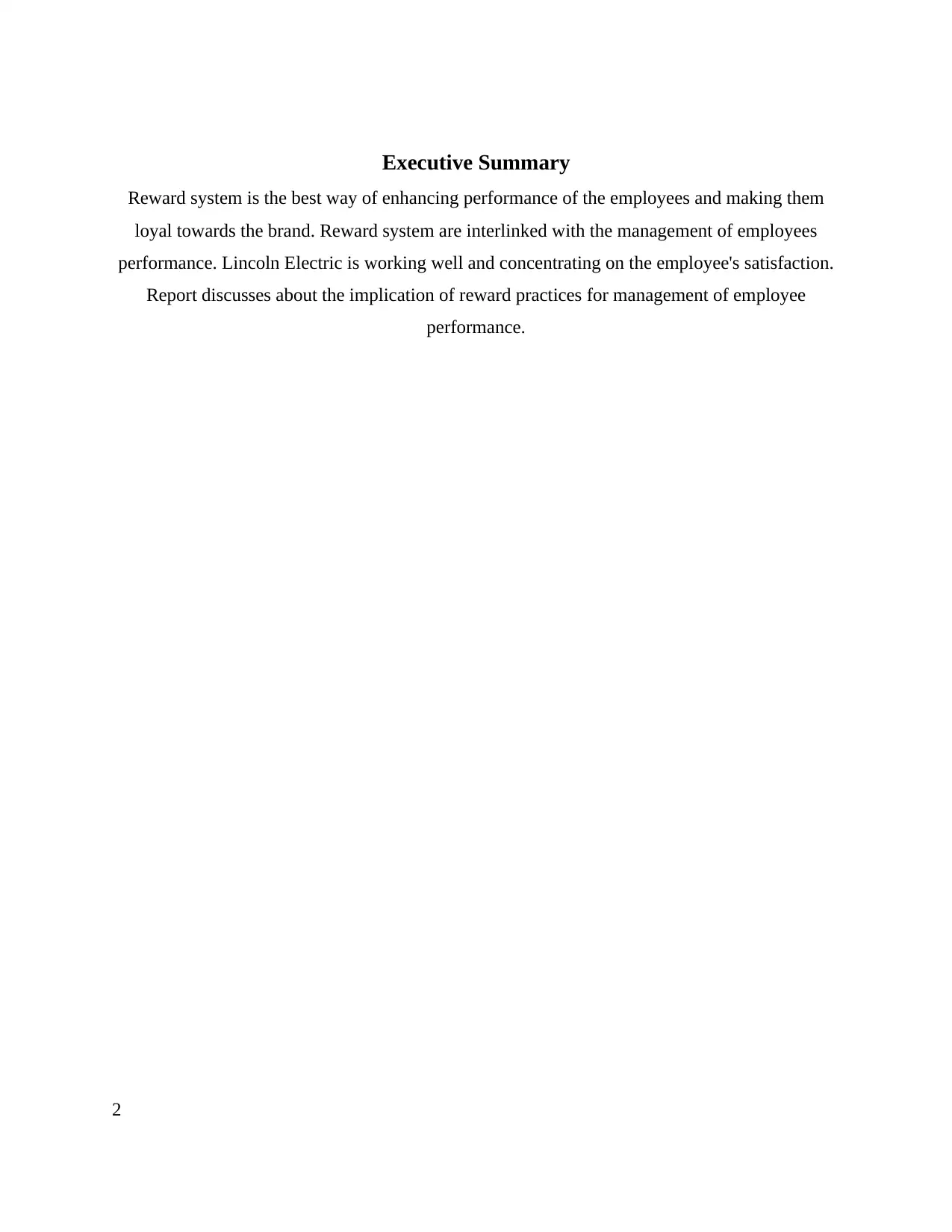
Executive Summary
Reward system is the best way of enhancing performance of the employees and making them
loyal towards the brand. Reward system are interlinked with the management of employees
performance. Lincoln Electric is working well and concentrating on the employee's satisfaction.
Report discusses about the implication of reward practices for management of employee
performance.
2
Reward system is the best way of enhancing performance of the employees and making them
loyal towards the brand. Reward system are interlinked with the management of employees
performance. Lincoln Electric is working well and concentrating on the employee's satisfaction.
Report discusses about the implication of reward practices for management of employee
performance.
2
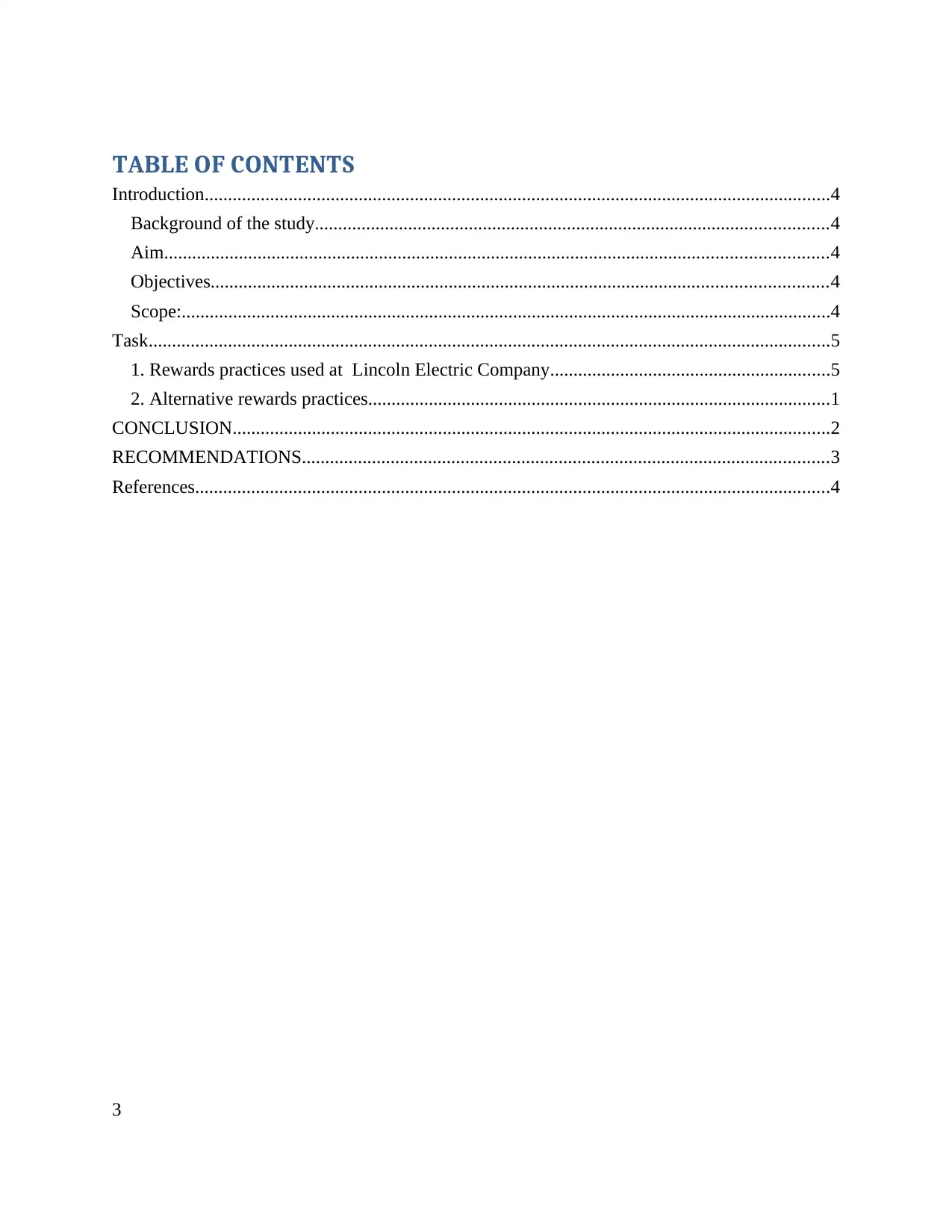
TABLE OF CONTENTS
Introduction......................................................................................................................................4
Background of the study..............................................................................................................4
Aim..............................................................................................................................................4
Objectives....................................................................................................................................4
Scope:...........................................................................................................................................4
Task..................................................................................................................................................5
1. Rewards practices used at Lincoln Electric Company............................................................5
2. Alternative rewards practices...................................................................................................1
CONCLUSION................................................................................................................................2
RECOMMENDATIONS.................................................................................................................3
References........................................................................................................................................4
3
Introduction......................................................................................................................................4
Background of the study..............................................................................................................4
Aim..............................................................................................................................................4
Objectives....................................................................................................................................4
Scope:...........................................................................................................................................4
Task..................................................................................................................................................5
1. Rewards practices used at Lincoln Electric Company............................................................5
2. Alternative rewards practices...................................................................................................1
CONCLUSION................................................................................................................................2
RECOMMENDATIONS.................................................................................................................3
References........................................................................................................................................4
3
⊘ This is a preview!⊘
Do you want full access?
Subscribe today to unlock all pages.

Trusted by 1+ million students worldwide
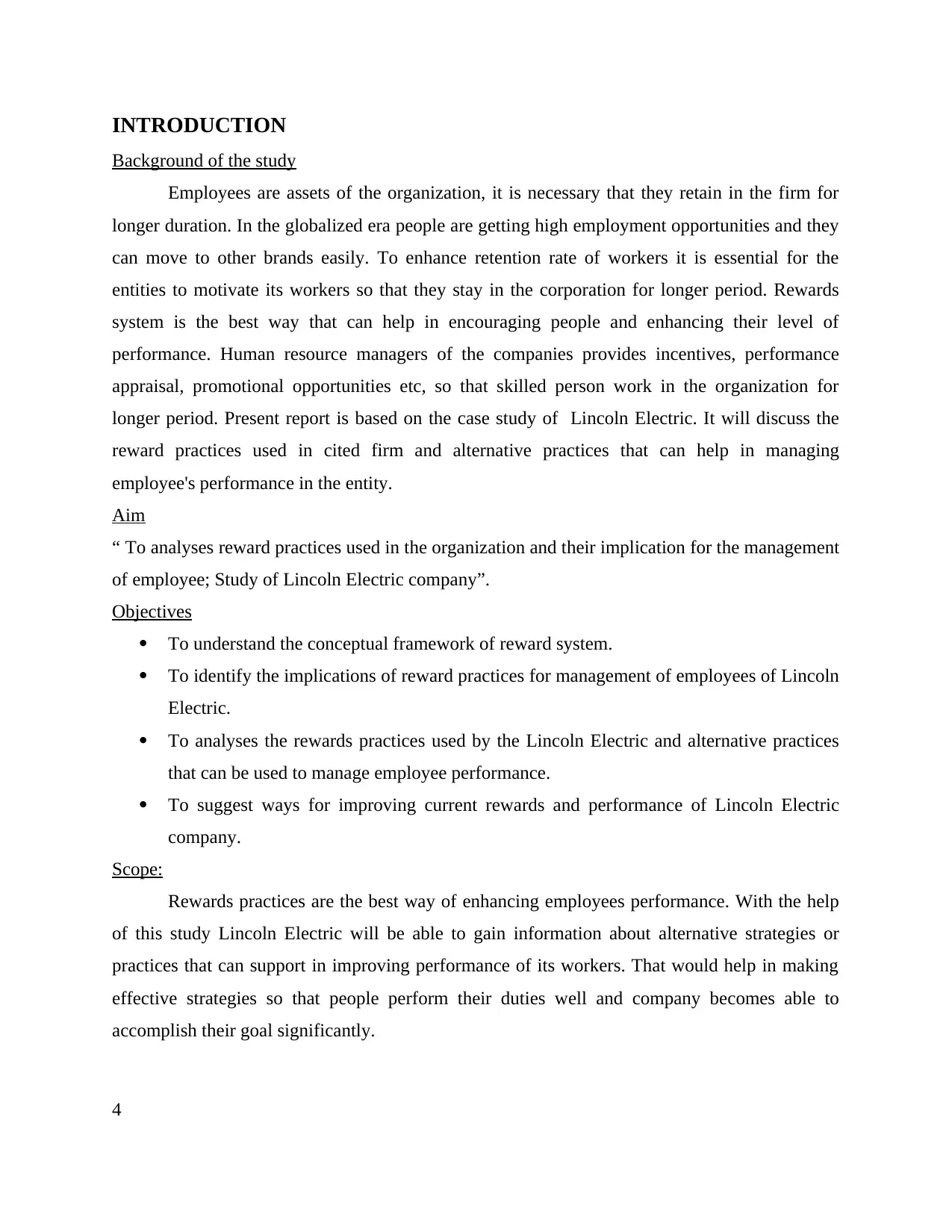
INTRODUCTION
Background of the study
Employees are assets of the organization, it is necessary that they retain in the firm for
longer duration. In the globalized era people are getting high employment opportunities and they
can move to other brands easily. To enhance retention rate of workers it is essential for the
entities to motivate its workers so that they stay in the corporation for longer period. Rewards
system is the best way that can help in encouraging people and enhancing their level of
performance. Human resource managers of the companies provides incentives, performance
appraisal, promotional opportunities etc, so that skilled person work in the organization for
longer period. Present report is based on the case study of Lincoln Electric. It will discuss the
reward practices used in cited firm and alternative practices that can help in managing
employee's performance in the entity.
Aim
“ To analyses reward practices used in the organization and their implication for the management
of employee; Study of Lincoln Electric company”.
Objectives
To understand the conceptual framework of reward system.
To identify the implications of reward practices for management of employees of Lincoln
Electric.
To analyses the rewards practices used by the Lincoln Electric and alternative practices
that can be used to manage employee performance.
To suggest ways for improving current rewards and performance of Lincoln Electric
company.
Scope:
Rewards practices are the best way of enhancing employees performance. With the help
of this study Lincoln Electric will be able to gain information about alternative strategies or
practices that can support in improving performance of its workers. That would help in making
effective strategies so that people perform their duties well and company becomes able to
accomplish their goal significantly.
4
Background of the study
Employees are assets of the organization, it is necessary that they retain in the firm for
longer duration. In the globalized era people are getting high employment opportunities and they
can move to other brands easily. To enhance retention rate of workers it is essential for the
entities to motivate its workers so that they stay in the corporation for longer period. Rewards
system is the best way that can help in encouraging people and enhancing their level of
performance. Human resource managers of the companies provides incentives, performance
appraisal, promotional opportunities etc, so that skilled person work in the organization for
longer period. Present report is based on the case study of Lincoln Electric. It will discuss the
reward practices used in cited firm and alternative practices that can help in managing
employee's performance in the entity.
Aim
“ To analyses reward practices used in the organization and their implication for the management
of employee; Study of Lincoln Electric company”.
Objectives
To understand the conceptual framework of reward system.
To identify the implications of reward practices for management of employees of Lincoln
Electric.
To analyses the rewards practices used by the Lincoln Electric and alternative practices
that can be used to manage employee performance.
To suggest ways for improving current rewards and performance of Lincoln Electric
company.
Scope:
Rewards practices are the best way of enhancing employees performance. With the help
of this study Lincoln Electric will be able to gain information about alternative strategies or
practices that can support in improving performance of its workers. That would help in making
effective strategies so that people perform their duties well and company becomes able to
accomplish their goal significantly.
4
Paraphrase This Document
Need a fresh take? Get an instant paraphrase of this document with our AI Paraphraser
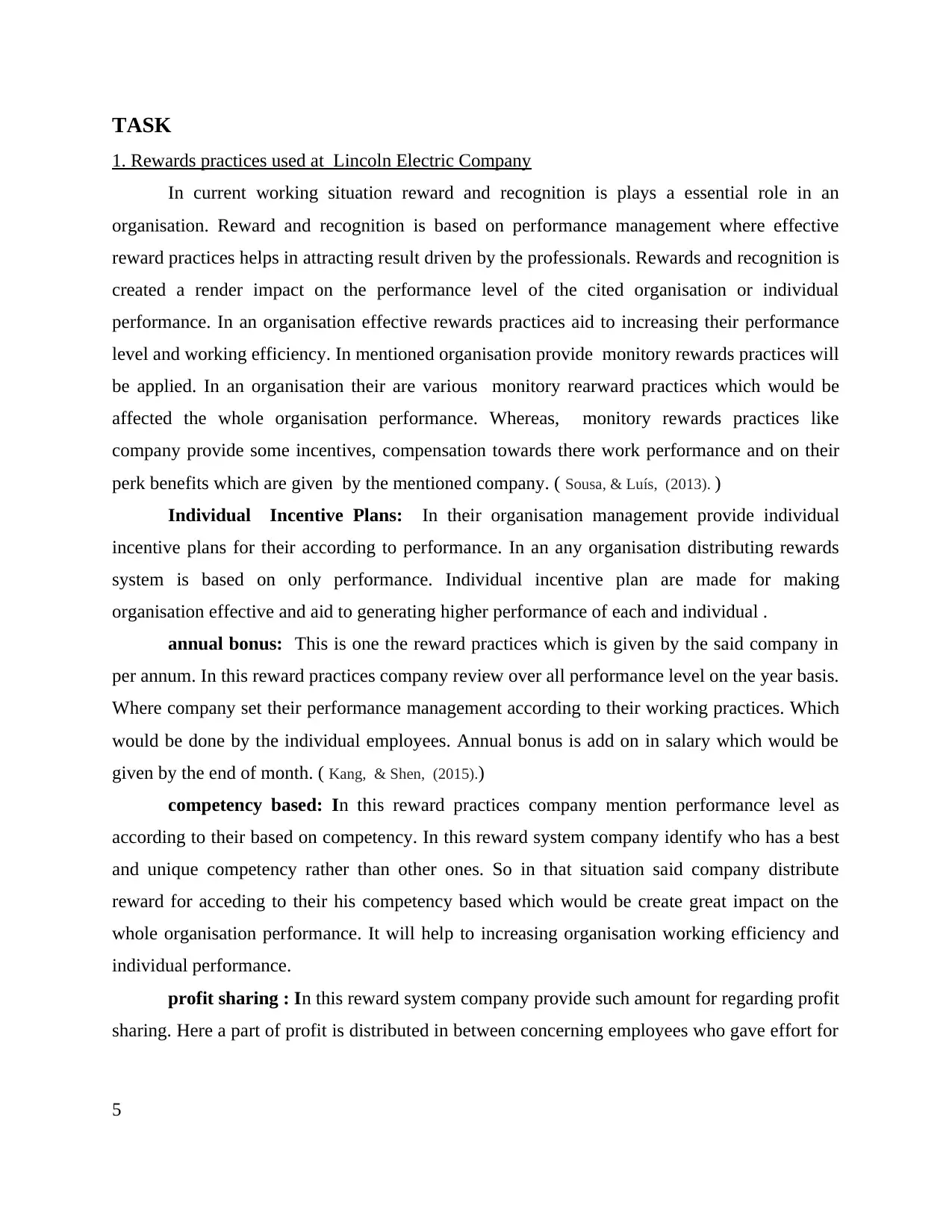
TASK
1. Rewards practices used at Lincoln Electric Company
In current working situation reward and recognition is plays a essential role in an
organisation. Reward and recognition is based on performance management where effective
reward practices helps in attracting result driven by the professionals. Rewards and recognition is
created a render impact on the performance level of the cited organisation or individual
performance. In an organisation effective rewards practices aid to increasing their performance
level and working efficiency. In mentioned organisation provide monitory rewards practices will
be applied. In an organisation their are various monitory rearward practices which would be
affected the whole organisation performance. Whereas, monitory rewards practices like
company provide some incentives, compensation towards there work performance and on their
perk benefits which are given by the mentioned company. ( Sousa, & Luís, (2013). )
Individual Incentive Plans: In their organisation management provide individual
incentive plans for their according to performance. In an any organisation distributing rewards
system is based on only performance. Individual incentive plan are made for making
organisation effective and aid to generating higher performance of each and individual .
annual bonus: This is one the reward practices which is given by the said company in
per annum. In this reward practices company review over all performance level on the year basis.
Where company set their performance management according to their working practices. Which
would be done by the individual employees. Annual bonus is add on in salary which would be
given by the end of month. ( Kang, & Shen, (2015).)
competency based: In this reward practices company mention performance level as
according to their based on competency. In this reward system company identify who has a best
and unique competency rather than other ones. So in that situation said company distribute
reward for acceding to their his competency based which would be create great impact on the
whole organisation performance. It will help to increasing organisation working efficiency and
individual performance.
profit sharing : In this reward system company provide such amount for regarding profit
sharing. Here a part of profit is distributed in between concerning employees who gave effort for
5
1. Rewards practices used at Lincoln Electric Company
In current working situation reward and recognition is plays a essential role in an
organisation. Reward and recognition is based on performance management where effective
reward practices helps in attracting result driven by the professionals. Rewards and recognition is
created a render impact on the performance level of the cited organisation or individual
performance. In an organisation effective rewards practices aid to increasing their performance
level and working efficiency. In mentioned organisation provide monitory rewards practices will
be applied. In an organisation their are various monitory rearward practices which would be
affected the whole organisation performance. Whereas, monitory rewards practices like
company provide some incentives, compensation towards there work performance and on their
perk benefits which are given by the mentioned company. ( Sousa, & Luís, (2013). )
Individual Incentive Plans: In their organisation management provide individual
incentive plans for their according to performance. In an any organisation distributing rewards
system is based on only performance. Individual incentive plan are made for making
organisation effective and aid to generating higher performance of each and individual .
annual bonus: This is one the reward practices which is given by the said company in
per annum. In this reward practices company review over all performance level on the year basis.
Where company set their performance management according to their working practices. Which
would be done by the individual employees. Annual bonus is add on in salary which would be
given by the end of month. ( Kang, & Shen, (2015).)
competency based: In this reward practices company mention performance level as
according to their based on competency. In this reward system company identify who has a best
and unique competency rather than other ones. So in that situation said company distribute
reward for acceding to their his competency based which would be create great impact on the
whole organisation performance. It will help to increasing organisation working efficiency and
individual performance.
profit sharing : In this reward system company provide such amount for regarding profit
sharing. Here a part of profit is distributed in between concerning employees who gave effort for
5
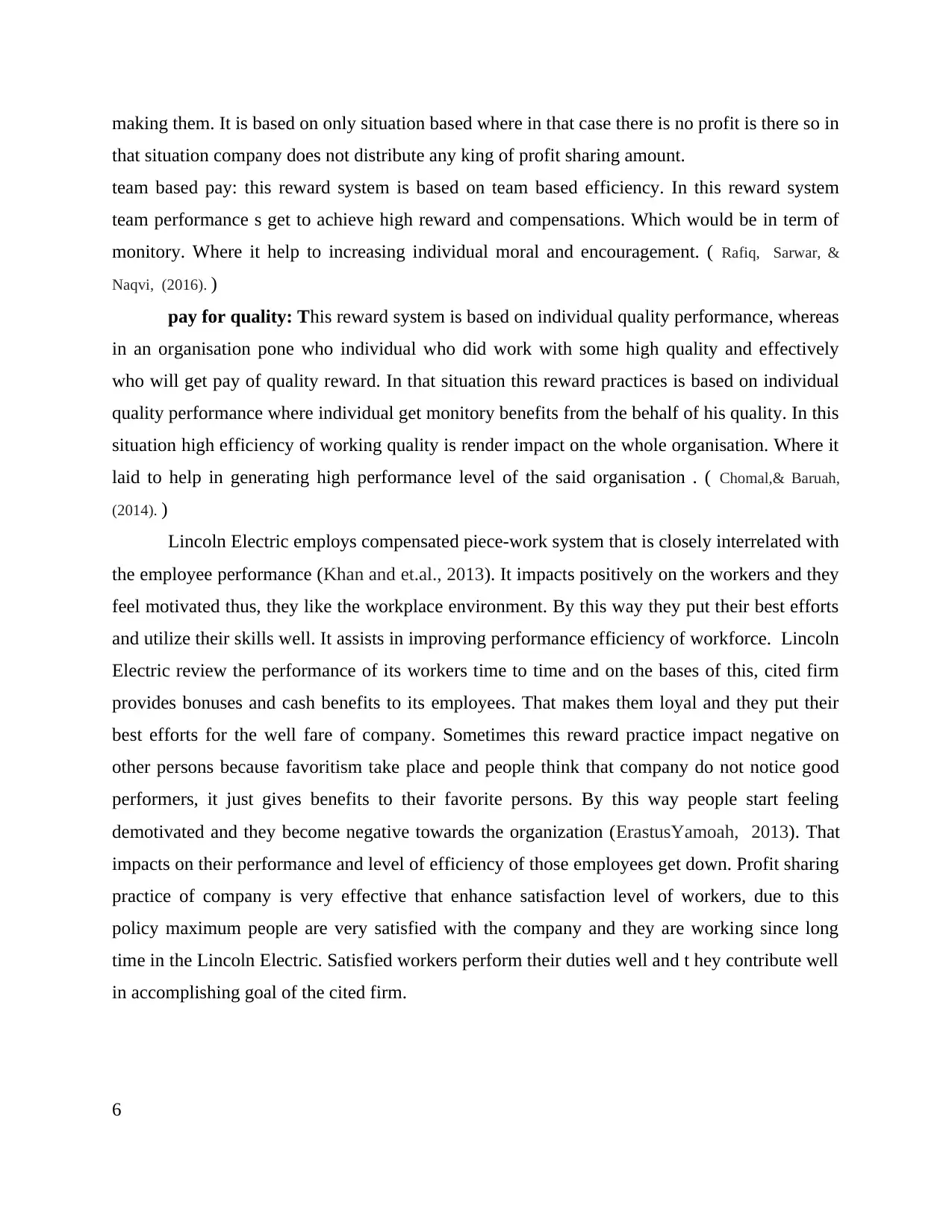
making them. It is based on only situation based where in that case there is no profit is there so in
that situation company does not distribute any king of profit sharing amount.
team based pay: this reward system is based on team based efficiency. In this reward system
team performance s get to achieve high reward and compensations. Which would be in term of
monitory. Where it help to increasing individual moral and encouragement. ( Rafiq, Sarwar, &
Naqvi, (2016). )
pay for quality: This reward system is based on individual quality performance, whereas
in an organisation pone who individual who did work with some high quality and effectively
who will get pay of quality reward. In that situation this reward practices is based on individual
quality performance where individual get monitory benefits from the behalf of his quality. In this
situation high efficiency of working quality is render impact on the whole organisation. Where it
laid to help in generating high performance level of the said organisation . ( Chomal,& Baruah,
(2014). )
Lincoln Electric employs compensated piece-work system that is closely interrelated with
the employee performance (Khan and et.al., 2013). It impacts positively on the workers and they
feel motivated thus, they like the workplace environment. By this way they put their best efforts
and utilize their skills well. It assists in improving performance efficiency of workforce. Lincoln
Electric review the performance of its workers time to time and on the bases of this, cited firm
provides bonuses and cash benefits to its employees. That makes them loyal and they put their
best efforts for the well fare of company. Sometimes this reward practice impact negative on
other persons because favoritism take place and people think that company do not notice good
performers, it just gives benefits to their favorite persons. By this way people start feeling
demotivated and they become negative towards the organization (ErastusYamoah, 2013). That
impacts on their performance and level of efficiency of those employees get down. Profit sharing
practice of company is very effective that enhance satisfaction level of workers, due to this
policy maximum people are very satisfied with the company and they are working since long
time in the Lincoln Electric. Satisfied workers perform their duties well and t hey contribute well
in accomplishing goal of the cited firm.
6
that situation company does not distribute any king of profit sharing amount.
team based pay: this reward system is based on team based efficiency. In this reward system
team performance s get to achieve high reward and compensations. Which would be in term of
monitory. Where it help to increasing individual moral and encouragement. ( Rafiq, Sarwar, &
Naqvi, (2016). )
pay for quality: This reward system is based on individual quality performance, whereas
in an organisation pone who individual who did work with some high quality and effectively
who will get pay of quality reward. In that situation this reward practices is based on individual
quality performance where individual get monitory benefits from the behalf of his quality. In this
situation high efficiency of working quality is render impact on the whole organisation. Where it
laid to help in generating high performance level of the said organisation . ( Chomal,& Baruah,
(2014). )
Lincoln Electric employs compensated piece-work system that is closely interrelated with
the employee performance (Khan and et.al., 2013). It impacts positively on the workers and they
feel motivated thus, they like the workplace environment. By this way they put their best efforts
and utilize their skills well. It assists in improving performance efficiency of workforce. Lincoln
Electric review the performance of its workers time to time and on the bases of this, cited firm
provides bonuses and cash benefits to its employees. That makes them loyal and they put their
best efforts for the well fare of company. Sometimes this reward practice impact negative on
other persons because favoritism take place and people think that company do not notice good
performers, it just gives benefits to their favorite persons. By this way people start feeling
demotivated and they become negative towards the organization (ErastusYamoah, 2013). That
impacts on their performance and level of efficiency of those employees get down. Profit sharing
practice of company is very effective that enhance satisfaction level of workers, due to this
policy maximum people are very satisfied with the company and they are working since long
time in the Lincoln Electric. Satisfied workers perform their duties well and t hey contribute well
in accomplishing goal of the cited firm.
6
⊘ This is a preview!⊘
Do you want full access?
Subscribe today to unlock all pages.

Trusted by 1+ million students worldwide
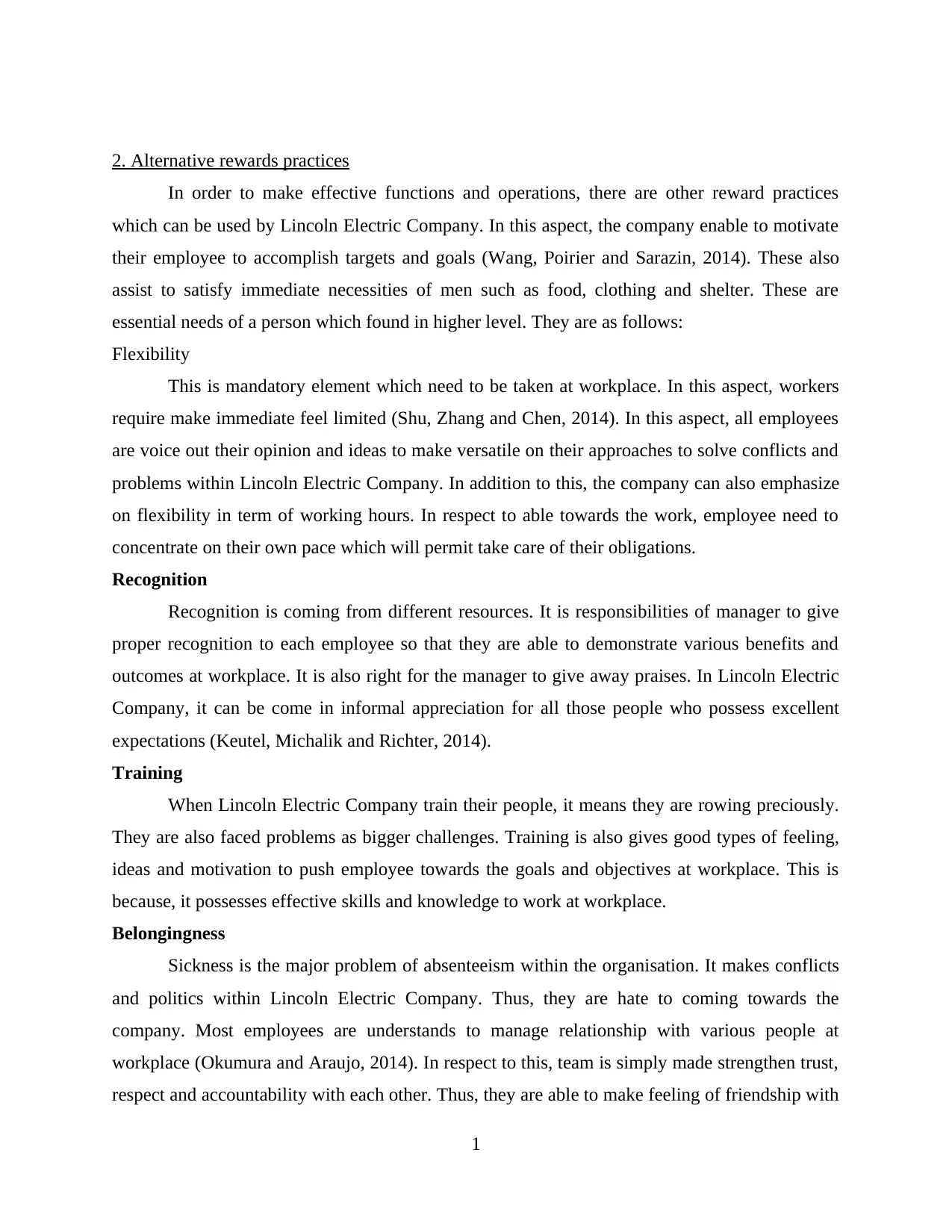
2. Alternative rewards practices
In order to make effective functions and operations, there are other reward practices
which can be used by Lincoln Electric Company. In this aspect, the company enable to motivate
their employee to accomplish targets and goals (Wang, Poirier and Sarazin, 2014). These also
assist to satisfy immediate necessities of men such as food, clothing and shelter. These are
essential needs of a person which found in higher level. They are as follows:
Flexibility
This is mandatory element which need to be taken at workplace. In this aspect, workers
require make immediate feel limited (Shu, Zhang and Chen, 2014). In this aspect, all employees
are voice out their opinion and ideas to make versatile on their approaches to solve conflicts and
problems within Lincoln Electric Company. In addition to this, the company can also emphasize
on flexibility in term of working hours. In respect to able towards the work, employee need to
concentrate on their own pace which will permit take care of their obligations.
Recognition
Recognition is coming from different resources. It is responsibilities of manager to give
proper recognition to each employee so that they are able to demonstrate various benefits and
outcomes at workplace. It is also right for the manager to give away praises. In Lincoln Electric
Company, it can be come in informal appreciation for all those people who possess excellent
expectations (Keutel, Michalik and Richter, 2014).
Training
When Lincoln Electric Company train their people, it means they are rowing preciously.
They are also faced problems as bigger challenges. Training is also gives good types of feeling,
ideas and motivation to push employee towards the goals and objectives at workplace. This is
because, it possesses effective skills and knowledge to work at workplace.
Belongingness
Sickness is the major problem of absenteeism within the organisation. It makes conflicts
and politics within Lincoln Electric Company. Thus, they are hate to coming towards the
company. Most employees are understands to manage relationship with various people at
workplace (Okumura and Araujo, 2014). In respect to this, team is simply made strengthen trust,
respect and accountability with each other. Thus, they are able to make feeling of friendship with
1
In order to make effective functions and operations, there are other reward practices
which can be used by Lincoln Electric Company. In this aspect, the company enable to motivate
their employee to accomplish targets and goals (Wang, Poirier and Sarazin, 2014). These also
assist to satisfy immediate necessities of men such as food, clothing and shelter. These are
essential needs of a person which found in higher level. They are as follows:
Flexibility
This is mandatory element which need to be taken at workplace. In this aspect, workers
require make immediate feel limited (Shu, Zhang and Chen, 2014). In this aspect, all employees
are voice out their opinion and ideas to make versatile on their approaches to solve conflicts and
problems within Lincoln Electric Company. In addition to this, the company can also emphasize
on flexibility in term of working hours. In respect to able towards the work, employee need to
concentrate on their own pace which will permit take care of their obligations.
Recognition
Recognition is coming from different resources. It is responsibilities of manager to give
proper recognition to each employee so that they are able to demonstrate various benefits and
outcomes at workplace. It is also right for the manager to give away praises. In Lincoln Electric
Company, it can be come in informal appreciation for all those people who possess excellent
expectations (Keutel, Michalik and Richter, 2014).
Training
When Lincoln Electric Company train their people, it means they are rowing preciously.
They are also faced problems as bigger challenges. Training is also gives good types of feeling,
ideas and motivation to push employee towards the goals and objectives at workplace. This is
because, it possesses effective skills and knowledge to work at workplace.
Belongingness
Sickness is the major problem of absenteeism within the organisation. It makes conflicts
and politics within Lincoln Electric Company. Thus, they are hate to coming towards the
company. Most employees are understands to manage relationship with various people at
workplace (Okumura and Araujo, 2014). In respect to this, team is simply made strengthen trust,
respect and accountability with each other. Thus, they are able to make feeling of friendship with
1
Paraphrase This Document
Need a fresh take? Get an instant paraphrase of this document with our AI Paraphraser
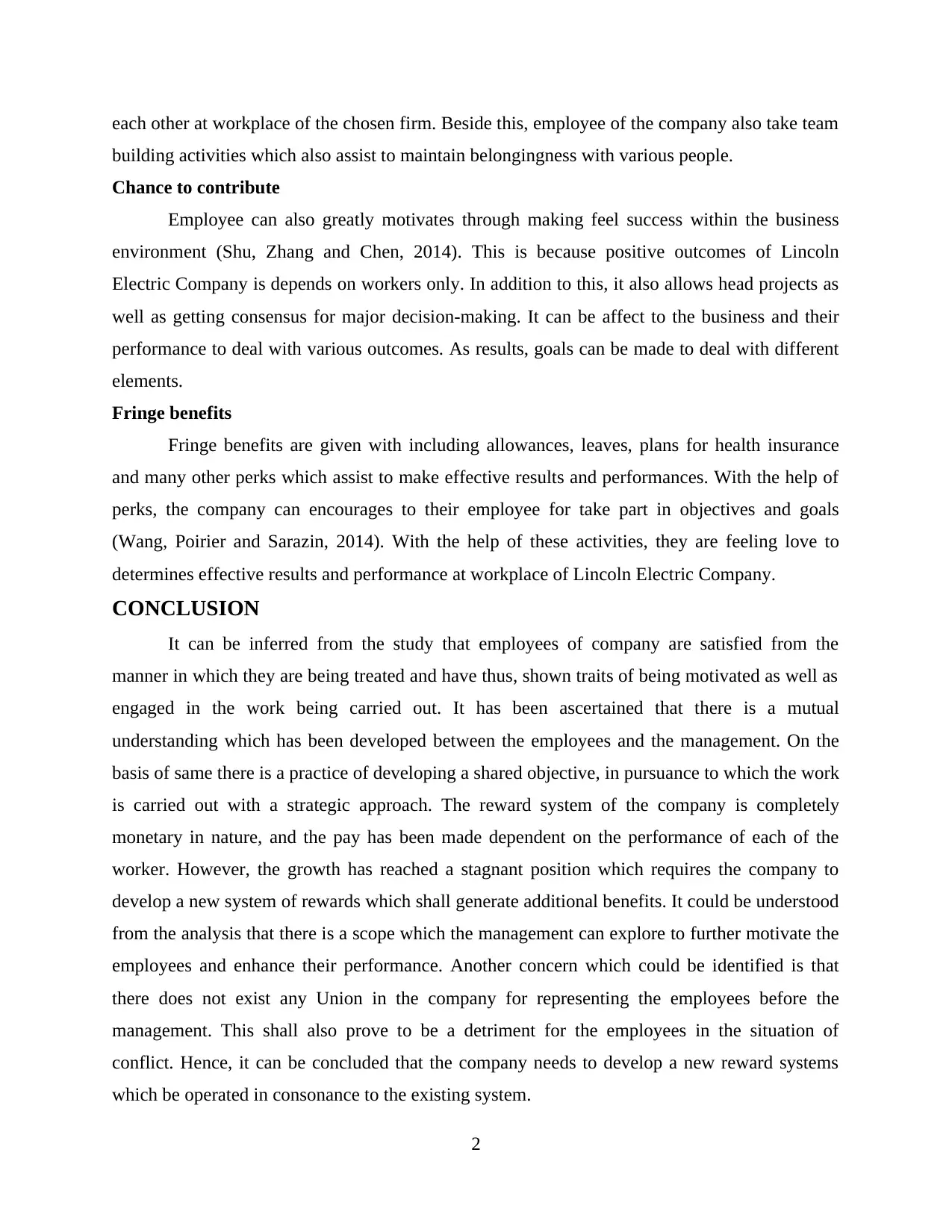
each other at workplace of the chosen firm. Beside this, employee of the company also take team
building activities which also assist to maintain belongingness with various people.
Chance to contribute
Employee can also greatly motivates through making feel success within the business
environment (Shu, Zhang and Chen, 2014). This is because positive outcomes of Lincoln
Electric Company is depends on workers only. In addition to this, it also allows head projects as
well as getting consensus for major decision-making. It can be affect to the business and their
performance to deal with various outcomes. As results, goals can be made to deal with different
elements.
Fringe benefits
Fringe benefits are given with including allowances, leaves, plans for health insurance
and many other perks which assist to make effective results and performances. With the help of
perks, the company can encourages to their employee for take part in objectives and goals
(Wang, Poirier and Sarazin, 2014). With the help of these activities, they are feeling love to
determines effective results and performance at workplace of Lincoln Electric Company.
CONCLUSION
It can be inferred from the study that employees of company are satisfied from the
manner in which they are being treated and have thus, shown traits of being motivated as well as
engaged in the work being carried out. It has been ascertained that there is a mutual
understanding which has been developed between the employees and the management. On the
basis of same there is a practice of developing a shared objective, in pursuance to which the work
is carried out with a strategic approach. The reward system of the company is completely
monetary in nature, and the pay has been made dependent on the performance of each of the
worker. However, the growth has reached a stagnant position which requires the company to
develop a new system of rewards which shall generate additional benefits. It could be understood
from the analysis that there is a scope which the management can explore to further motivate the
employees and enhance their performance. Another concern which could be identified is that
there does not exist any Union in the company for representing the employees before the
management. This shall also prove to be a detriment for the employees in the situation of
conflict. Hence, it can be concluded that the company needs to develop a new reward systems
which be operated in consonance to the existing system.
2
building activities which also assist to maintain belongingness with various people.
Chance to contribute
Employee can also greatly motivates through making feel success within the business
environment (Shu, Zhang and Chen, 2014). This is because positive outcomes of Lincoln
Electric Company is depends on workers only. In addition to this, it also allows head projects as
well as getting consensus for major decision-making. It can be affect to the business and their
performance to deal with various outcomes. As results, goals can be made to deal with different
elements.
Fringe benefits
Fringe benefits are given with including allowances, leaves, plans for health insurance
and many other perks which assist to make effective results and performances. With the help of
perks, the company can encourages to their employee for take part in objectives and goals
(Wang, Poirier and Sarazin, 2014). With the help of these activities, they are feeling love to
determines effective results and performance at workplace of Lincoln Electric Company.
CONCLUSION
It can be inferred from the study that employees of company are satisfied from the
manner in which they are being treated and have thus, shown traits of being motivated as well as
engaged in the work being carried out. It has been ascertained that there is a mutual
understanding which has been developed between the employees and the management. On the
basis of same there is a practice of developing a shared objective, in pursuance to which the work
is carried out with a strategic approach. The reward system of the company is completely
monetary in nature, and the pay has been made dependent on the performance of each of the
worker. However, the growth has reached a stagnant position which requires the company to
develop a new system of rewards which shall generate additional benefits. It could be understood
from the analysis that there is a scope which the management can explore to further motivate the
employees and enhance their performance. Another concern which could be identified is that
there does not exist any Union in the company for representing the employees before the
management. This shall also prove to be a detriment for the employees in the situation of
conflict. Hence, it can be concluded that the company needs to develop a new reward systems
which be operated in consonance to the existing system.
2
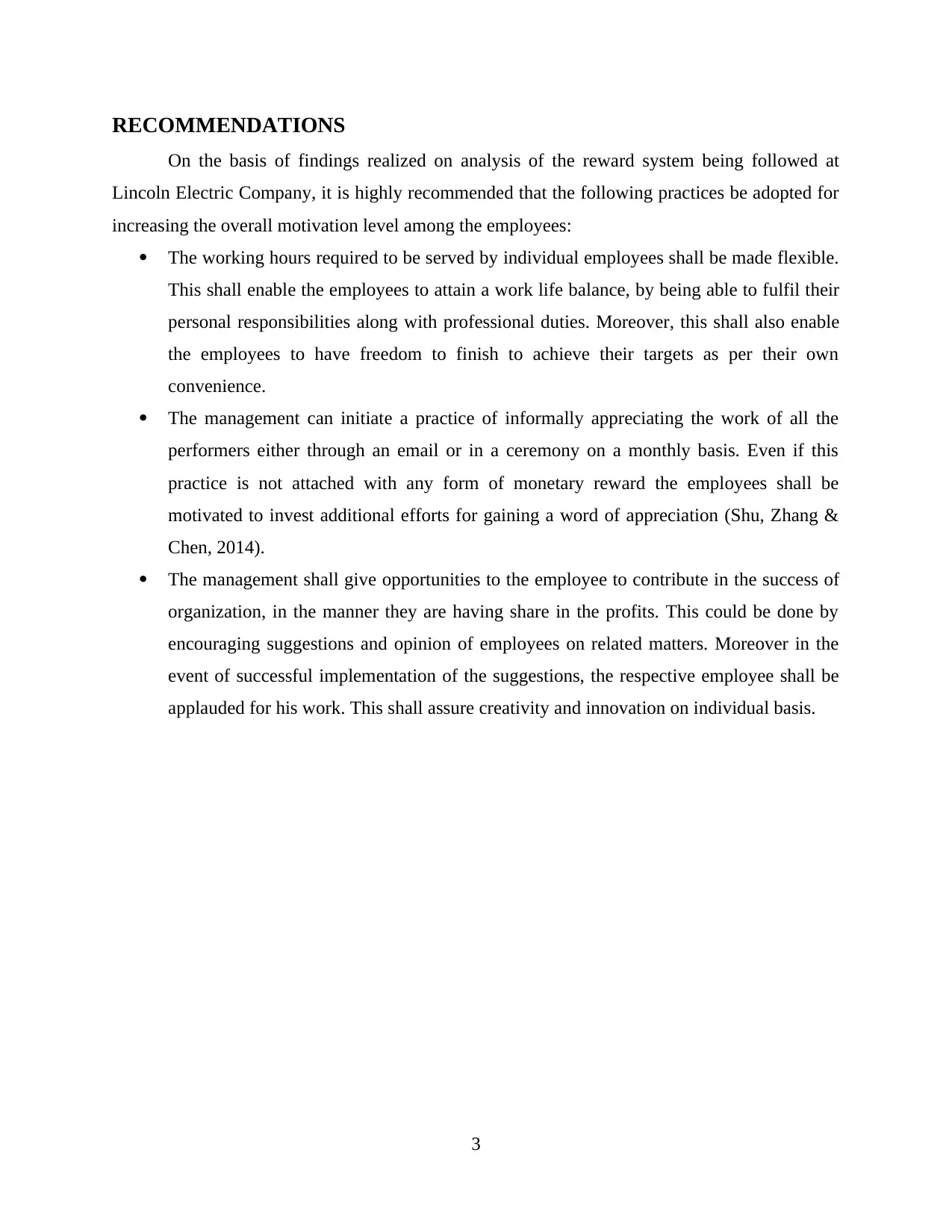
RECOMMENDATIONS
On the basis of findings realized on analysis of the reward system being followed at
Lincoln Electric Company, it is highly recommended that the following practices be adopted for
increasing the overall motivation level among the employees:
The working hours required to be served by individual employees shall be made flexible.
This shall enable the employees to attain a work life balance, by being able to fulfil their
personal responsibilities along with professional duties. Moreover, this shall also enable
the employees to have freedom to finish to achieve their targets as per their own
convenience.
The management can initiate a practice of informally appreciating the work of all the
performers either through an email or in a ceremony on a monthly basis. Even if this
practice is not attached with any form of monetary reward the employees shall be
motivated to invest additional efforts for gaining a word of appreciation (Shu, Zhang &
Chen, 2014).
The management shall give opportunities to the employee to contribute in the success of
organization, in the manner they are having share in the profits. This could be done by
encouraging suggestions and opinion of employees on related matters. Moreover in the
event of successful implementation of the suggestions, the respective employee shall be
applauded for his work. This shall assure creativity and innovation on individual basis.
3
On the basis of findings realized on analysis of the reward system being followed at
Lincoln Electric Company, it is highly recommended that the following practices be adopted for
increasing the overall motivation level among the employees:
The working hours required to be served by individual employees shall be made flexible.
This shall enable the employees to attain a work life balance, by being able to fulfil their
personal responsibilities along with professional duties. Moreover, this shall also enable
the employees to have freedom to finish to achieve their targets as per their own
convenience.
The management can initiate a practice of informally appreciating the work of all the
performers either through an email or in a ceremony on a monthly basis. Even if this
practice is not attached with any form of monetary reward the employees shall be
motivated to invest additional efforts for gaining a word of appreciation (Shu, Zhang &
Chen, 2014).
The management shall give opportunities to the employee to contribute in the success of
organization, in the manner they are having share in the profits. This could be done by
encouraging suggestions and opinion of employees on related matters. Moreover in the
event of successful implementation of the suggestions, the respective employee shall be
applauded for his work. This shall assure creativity and innovation on individual basis.
3
⊘ This is a preview!⊘
Do you want full access?
Subscribe today to unlock all pages.

Trusted by 1+ million students worldwide
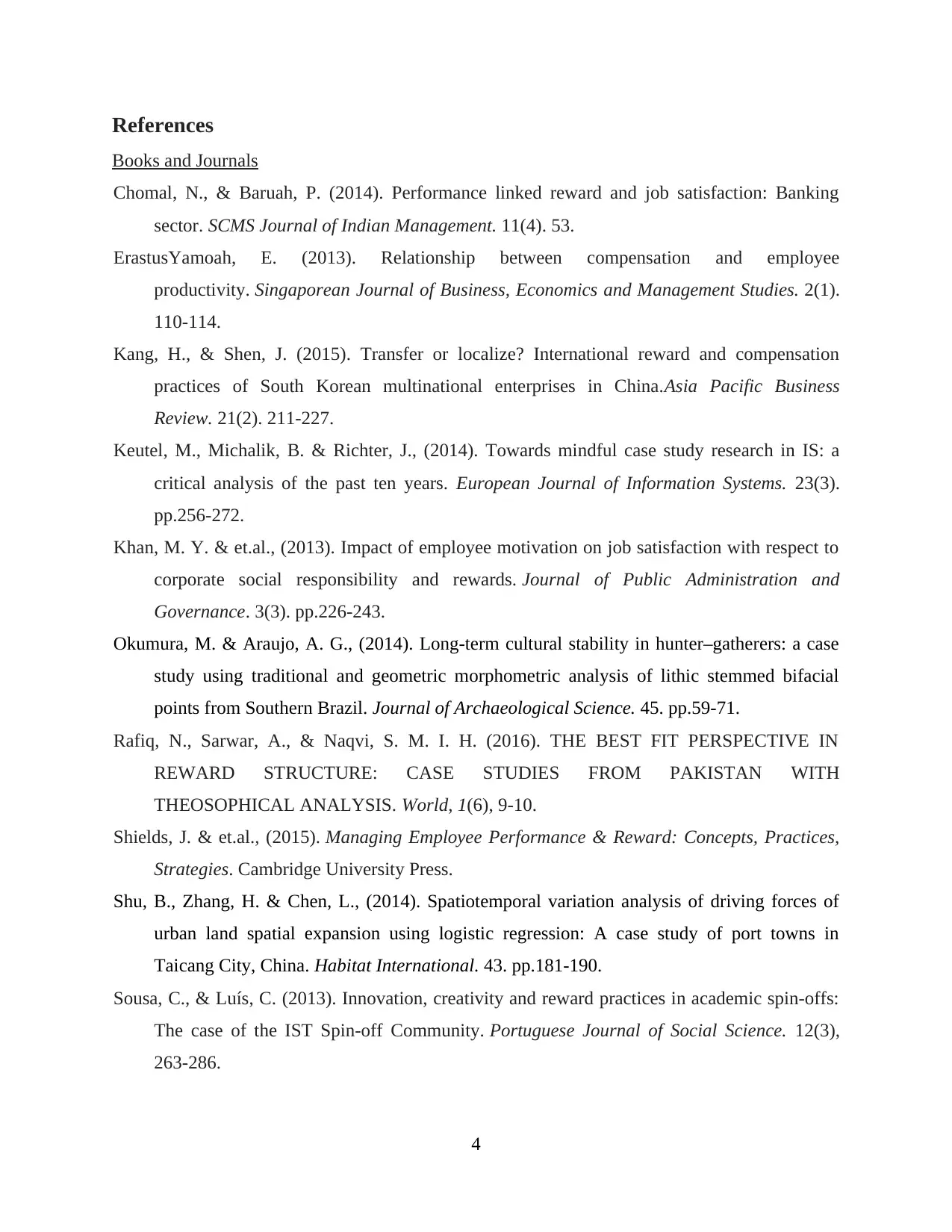
References
Books and Journals
Chomal, N., & Baruah, P. (2014). Performance linked reward and job satisfaction: Banking
sector. SCMS Journal of Indian Management. 11(4). 53.
ErastusYamoah, E. (2013). Relationship between compensation and employee
productivity. Singaporean Journal of Business, Economics and Management Studies. 2(1).
110-114.
Kang, H., & Shen, J. (2015). Transfer or localize? International reward and compensation
practices of South Korean multinational enterprises in China.Asia Pacific Business
Review. 21(2). 211-227.
Keutel, M., Michalik, B. & Richter, J., (2014). Towards mindful case study research in IS: a
critical analysis of the past ten years. European Journal of Information Systems. 23(3).
pp.256-272.
Khan, M. Y. & et.al., (2013). Impact of employee motivation on job satisfaction with respect to
corporate social responsibility and rewards. Journal of Public Administration and
Governance. 3(3). pp.226-243.
Okumura, M. & Araujo, A. G., (2014). Long-term cultural stability in hunter–gatherers: a case
study using traditional and geometric morphometric analysis of lithic stemmed bifacial
points from Southern Brazil. Journal of Archaeological Science. 45. pp.59-71.
Rafiq, N., Sarwar, A., & Naqvi, S. M. I. H. (2016). THE BEST FIT PERSPECTIVE IN
REWARD STRUCTURE: CASE STUDIES FROM PAKISTAN WITH
THEOSOPHICAL ANALYSIS. World, 1(6), 9-10.
Shields, J. & et.al., (2015). Managing Employee Performance & Reward: Concepts, Practices,
Strategies. Cambridge University Press.
Shu, B., Zhang, H. & Chen, L., (2014). Spatiotemporal variation analysis of driving forces of
urban land spatial expansion using logistic regression: A case study of port towns in
Taicang City, China. Habitat International. 43. pp.181-190.
Sousa, C., & Luís, C. (2013). Innovation, creativity and reward practices in academic spin-offs:
The case of the IST Spin-off Community. Portuguese Journal of Social Science. 12(3),
263-286.
4
Books and Journals
Chomal, N., & Baruah, P. (2014). Performance linked reward and job satisfaction: Banking
sector. SCMS Journal of Indian Management. 11(4). 53.
ErastusYamoah, E. (2013). Relationship between compensation and employee
productivity. Singaporean Journal of Business, Economics and Management Studies. 2(1).
110-114.
Kang, H., & Shen, J. (2015). Transfer or localize? International reward and compensation
practices of South Korean multinational enterprises in China.Asia Pacific Business
Review. 21(2). 211-227.
Keutel, M., Michalik, B. & Richter, J., (2014). Towards mindful case study research in IS: a
critical analysis of the past ten years. European Journal of Information Systems. 23(3).
pp.256-272.
Khan, M. Y. & et.al., (2013). Impact of employee motivation on job satisfaction with respect to
corporate social responsibility and rewards. Journal of Public Administration and
Governance. 3(3). pp.226-243.
Okumura, M. & Araujo, A. G., (2014). Long-term cultural stability in hunter–gatherers: a case
study using traditional and geometric morphometric analysis of lithic stemmed bifacial
points from Southern Brazil. Journal of Archaeological Science. 45. pp.59-71.
Rafiq, N., Sarwar, A., & Naqvi, S. M. I. H. (2016). THE BEST FIT PERSPECTIVE IN
REWARD STRUCTURE: CASE STUDIES FROM PAKISTAN WITH
THEOSOPHICAL ANALYSIS. World, 1(6), 9-10.
Shields, J. & et.al., (2015). Managing Employee Performance & Reward: Concepts, Practices,
Strategies. Cambridge University Press.
Shu, B., Zhang, H. & Chen, L., (2014). Spatiotemporal variation analysis of driving forces of
urban land spatial expansion using logistic regression: A case study of port towns in
Taicang City, China. Habitat International. 43. pp.181-190.
Sousa, C., & Luís, C. (2013). Innovation, creativity and reward practices in academic spin-offs:
The case of the IST Spin-off Community. Portuguese Journal of Social Science. 12(3),
263-286.
4
Paraphrase This Document
Need a fresh take? Get an instant paraphrase of this document with our AI Paraphraser
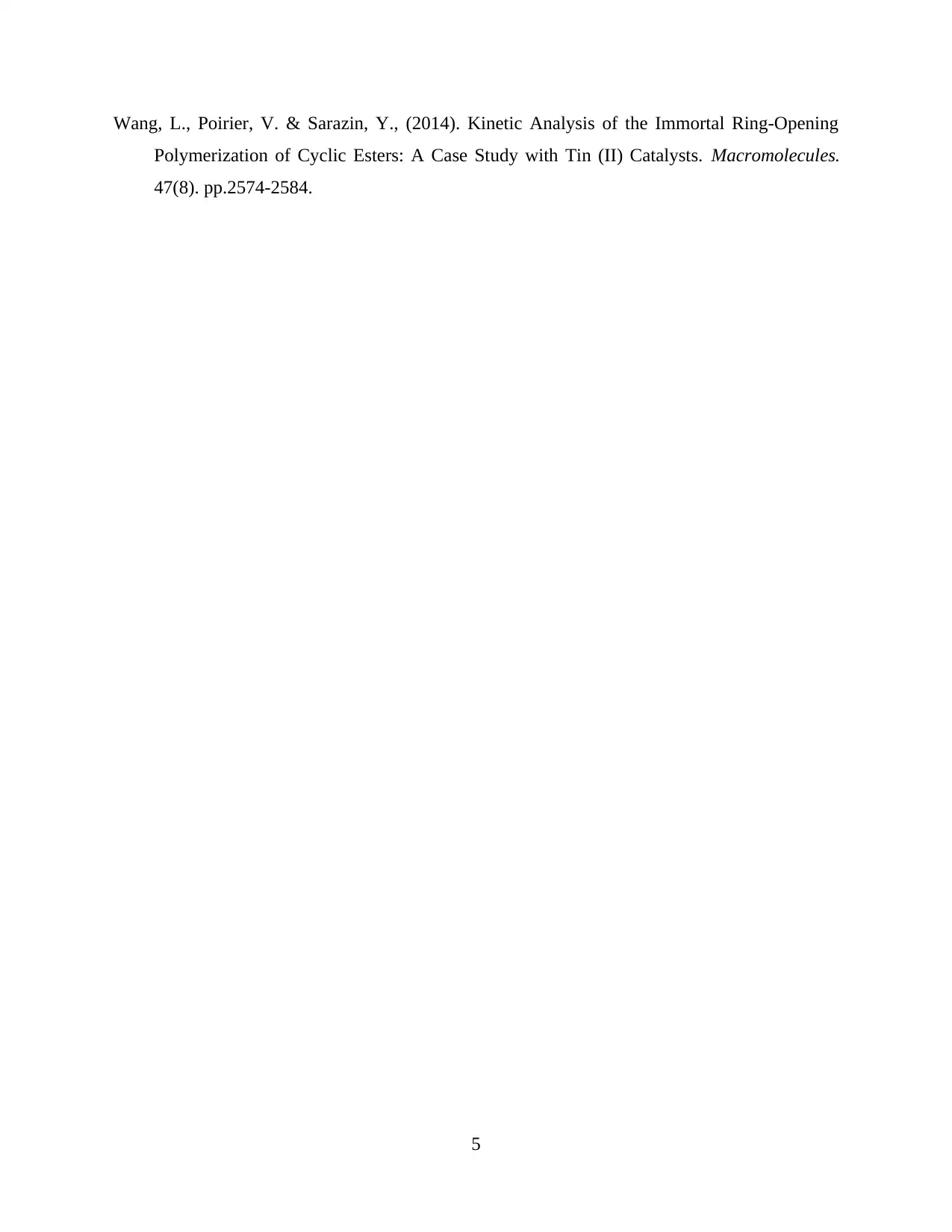
Wang, L., Poirier, V. & Sarazin, Y., (2014). Kinetic Analysis of the Immortal Ring-Opening
Polymerization of Cyclic Esters: A Case Study with Tin (II) Catalysts. Macromolecules.
47(8). pp.2574-2584.
5
Polymerization of Cyclic Esters: A Case Study with Tin (II) Catalysts. Macromolecules.
47(8). pp.2574-2584.
5
1 out of 11
Related Documents
Your All-in-One AI-Powered Toolkit for Academic Success.
+13062052269
info@desklib.com
Available 24*7 on WhatsApp / Email
![[object Object]](/_next/static/media/star-bottom.7253800d.svg)
Unlock your academic potential
Copyright © 2020–2025 A2Z Services. All Rights Reserved. Developed and managed by ZUCOL.





